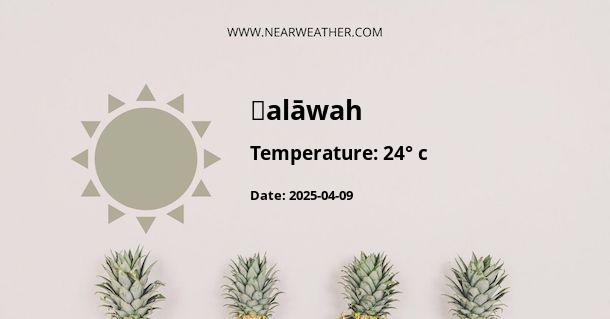Climate and Weather Overview of Halawah, Jordan
Halawah, a serene location nestled in the heart of Jordan, offers a diverse climate that is typical of the broader Middle Eastern region. The city's climate is primarily desert-like, characterized by dramatic temperature fluctuations between day and night, and between seasons. This article will present a comprehensive analysis of Halawah's climate and weather patterns throughout the year.
Climate Classification
Halawah falls within the BWh climate classification according to the Köppen-Geiger system. This classification is characterized by an arid, desert climate with extremely low annual rainfall.
Annual Temperature Overview
In Halawah, the average annual temperature is approximately 20.2 °C. The city experiences significant temperature variation throughout the year, with January being the coldest month and August being the warmest.
"The temperature in Halawah varies significantly from the winter months to the summer months, making it a place of climatic contrast."
Seasonal Weather Patterns
Spring (March - May)
Spring in Halawah is typically warm and dry, with an average temperature range of 20°C - 25°C. Rainfall is sporadic and minimal during this period, making it an excellent time for outdoor activities.
Summer (June - August)
Summers in Halawah are typically very hot with temperatures often exceeding 35°C. The heat is often exacerbated by the dry air and lack of cloud cover. Rainfall during this season is almost non-existent.
Autumn (September - November)
Autumn brings a slight relief from the intense summer heat. Temperatures during this period average between 25°C and 30°C. Although rainfall remains infrequent, the likelihood of precipitation increases towards the end of the season.
Winter (December - February)
Winters in Halawah are mild and dry, with temperatures averaging between 10°C and 15°C. Despite being the 'wet' season, rainfall is still relatively low with occasional showers.
Precipitation
The annual rainfall in Halawah is approximately 111 mm. The chart below illustrates the monthly distribution of rainfall throughout the year.
| Month | Rainfall (mm) |
|---|---|
| January | 22 |
| February | 20 |
| March | 15 |
| April | 8 |
| May | 3 |
| June | 0 |
| July | 0 |
| August | 0 |
| September | 1 |
| October | 5 |
| November | 10 |
| December | 27 |
Climate Impact on Lifestyle and Tourism
The arid desert climate in Halawah has a significant impact on the local lifestyle and tourism industry. The hot and dry summer months are usually less favorable for tourism, while the milder spring and autumn seasons attract visitors seeking outdoor adventures and cultural exploration.
"Despite its harsh climate, Halawah's unique charm lies in its stark desert beauty, historical landmarks, and rich cultural heritage."
Conclusion
In conclusion, Halawah's climate is largely influenced by its geographical location in the heart of the Jordanian desert. The city experiences significant temperature fluctuations throughout the year, with exceptionally hot summers and mildly cold winters. Despite its arid climate, Halawah offers a unique travel experience steeped in cultural and historical richness.
A - Ḩalāwah's Latitude is 32.384640 & Longitude is 35.661469.
A - Weather in Ḩalāwah is 24° today.
A - Climate Conditions in Ḩalāwah shows scattered clouds today.
A - Humidity in Ḩalāwah is 37% today.
A - Wind speed in Ḩalāwah is 14.76 km/h, flowing at 289° wind direction. today.
